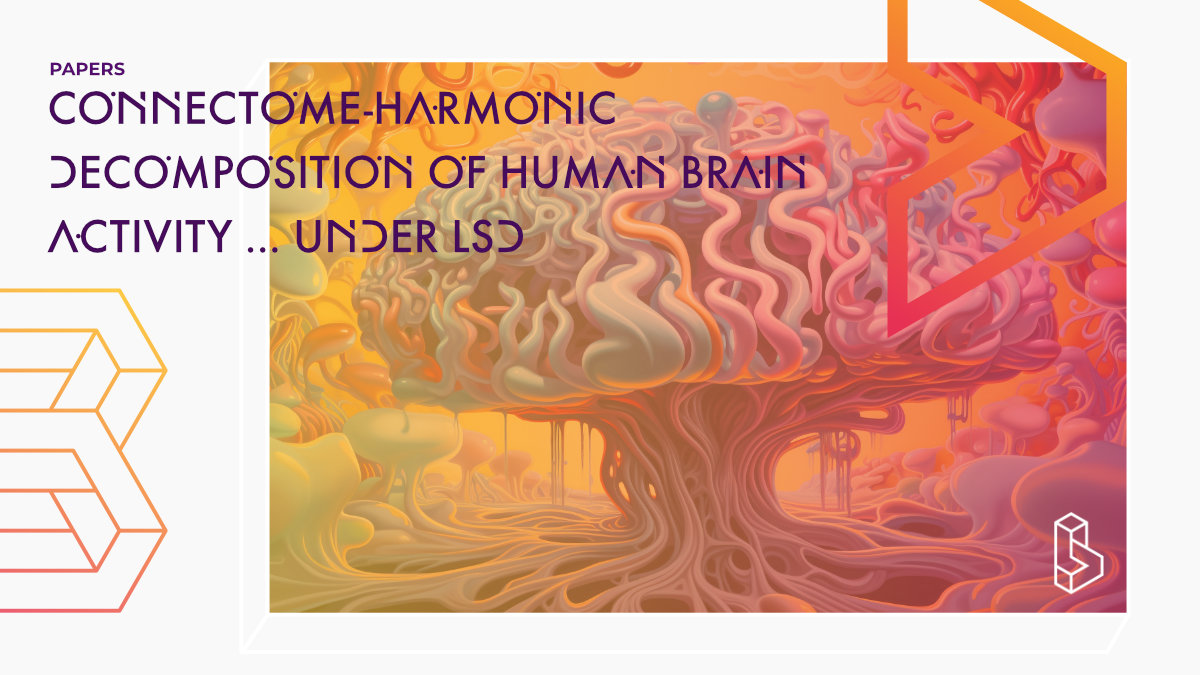This placebo-controlled within-subjects study (n=12) analyzed fMRI data of participants’ brain activity in response to LSD (75μg/70kg) with or without the influence of listening to music. Using a novel connectome-specific harmonic decomposition method, they found that brain states under the influence of LSD exhibit a wider and more flexible repertoire of activation patterns, which maintain a unique type of non-random stability in their co-activation over time.
Abstract of Connectome-harmonic decomposition of human brain activity
“Introduction: Recent studies have started to elucidate the effects of lysergic acid diethylamide (LSD) on the human brain but the underlying dynamics are not yet fully understood.
Methods: Here we used ’connectome-harmonic decomposition’, a novel method to investigate the dynamical changes in brain states.
Results: We found that LSD alters the energy and the power of individual harmonic brain states in a frequency-selective manner. Remarkably, this leads to an expansion of the repertoire of active brain states, suggestive of a general re-organization of brain dynamics given the non-random increase in co-activation across frequencies. Interestingly, the frequency distribution of the active repertoire of brain states under LSD closely follows power-laws indicating a re-organization of the dynamics at the edge of criticality.
Discussion: Beyond the present findings, these methods open up for a better understanding of the complex brain dynamics in health and disease.”
Authors: Selen Atasoy, Leor Roseman, Mendel Kaelen, Morten L. Kringelbach, Gustavo Deco & Robin L. Carhart-Harris
Summary of Connectome-harmonic decomposition of human brain activity
LSD was discovered in 1943 and was used to explore and understand consciousness, psychopathology and mental illness for 15 years. Now, with significant advances in functional neuroimaging, psychology is beginning to embrace and exploit this powerful scientific tool.
Previous fMRI and MEG work has reported increased visual cortex blood flow, increased whole-brain functional integration, and decreased oscillatory power across a broad frequency range under LSD. This work describes a novel method to decompose resting-state fMRI data under LSD and placebo into a set of independent, frequency-specific brain states.
Our technique capitalizes on the identification of the brain states as harmonic modes of the brain’s structural connectivity and the decomposition of fMRI-measured cortical activity patterns into these harmonic brain states. This approach provides a set of independent and fully synchronous brain states with increasing spatial frequency. The activation of harmonic brain states composes the complex spatio-temporal dynamics of cortical activity, and the evaluation of fundamental properties of these harmonic brain states enables novel tools for neuroscience.
Find this paper
https://doi.org/10.1038/s41598-017-17546-0
Open Access | Google Scholar | Backup | 🕊
Cite this paper (APA)
Atasoy, S., Roseman, L., Kaelen, M., Kringelbach, M. L., Deco, G., & Carhart-Harris, R. L. (2017). Connectome-harmonic decomposition of human brain activity reveals dynamical repertoire re-organization under LSD. Scientific reports, 7(1), 17661.
Study details
Compounds studied
LSD
Topics studied
Neuroscience
Study characteristics
Original
Placebo-Controlled
Single-Blind
Within-Subject
Randomized
Participants
12
Humans
Authors
Authors associated with this publication with profiles on Blossom
Leor RosemanLeor Roseman is a researcher at the Centre for Psychedelic Research, Imperial College London. His work focussed on psilocybin for depression, but is now related to peace-building through psychedelics.
Robin Carhart-Harris
Dr. Robin Carhart-Harris is the Founding Director of the Neuroscape Psychedelics Division at UCSF. Previously he led the Psychedelic group at Imperial College London.
Shannon Dames
Dr Shannon Dames is a Professor of Nursing at Vancouver Island University.
Compound Details
The psychedelics given at which dose and how many times
LSD 75 μg | 1xLinked Research Papers
Notable research papers that build on or are influenced by this paper
Distributed harmonic patterns of structure-function dependence orchestrate human consciousnessThis theory-building paper (2023) shows that structure-function coupling (patterns of brain activity) is a generalisable indicator of consciousness. An increase in functional coupling indicates a loss of consciousness (e.g. brain-inured patients or anaesthesia), and opposite changes (decoupling of brain function from structure) are seen under the influence of psychedelics (e.g. LSD or ketamine).

